BIM-Based Visualization Research in the Construction Industry: A Network Analysis
Abstract
1. Introduction
2. Research Methodology
3. Results and Discussions
3.1. Network of Co-Authorship
3.2. Network of Countries/Regions
3.3. Network of Published Journals
3.4. Network of Article Citations
3.5. Network of Co-Occurring Keywords
4. Discussions
5. Conclusions
Author Contributions
Funding
Acknowledgments
Conflicts of Interest
References
- NIBS. What Is a BIM. Available online: https://www.nationalbimstandard.org/faqs (accessed on 13 August 2019).
- Ding, L.; Xu, X. Application of cloud storage on BIM life-cycle management. Int. J. Adv. Rob. Syst. 2014, 11, 129. [Google Scholar] [CrossRef]
- Zhang, S.; Teizer, J.; Pradhananga, N.; Eastman, C.M. Workforce location tracking to model, visualize and analyze workspace requirements in building information models for construction safety planning. Autom. Constr. 2015, 60, 74–86. [Google Scholar] [CrossRef]
- Chen, W.; Chen, K.; Cheng, J.C.P.; Wang, Q.; Gan, V.J.L. BIM-based framework for automatic scheduling of facility maintenance work orders. Autom. Constr. 2018, 91, 15–30. [Google Scholar] [CrossRef]
- Wang, Y.; Li, H.; Wu, Z. Attitude of the Chinese public toward off-site construction: A text mining study. J. Clean. Prod. 2019, 238, 117926. [Google Scholar] [CrossRef]
- Wu, Z.; Li, H.; Feng, Y.; Luo, X.; Chen, Q. Developing a green building evaluation standard for interior decoration: A case study of China. Build. Environ. 2019, 152, 50–58. [Google Scholar] [CrossRef]
- Hong, J.; Tang, M.; Wu, Z.; Miao, Z.; Shen, G.Q. The evolution of patterns within embodied energy flows in the Chinese economy: A multi-regional-based complex network approach. Sustain. Cities Soc. 2019, 47, 101500. [Google Scholar] [CrossRef]
- Zhang, L.; Guo, S.; Wu, Z.; Alsaedi, A.; Hayat, T. SWOT Analysis for the Promotion of Energy Efficiency in Rural Buildings: A Case Study of China. Energies 2018, 11, 851. [Google Scholar] [CrossRef]
- Wu, Z.; Yu, A.T.W.; Shen, L. Investigating the determinants of contractor’s construction and demolition waste management behavior in Mainland China. Waste Manag. 2017, 60, 290–300. [Google Scholar] [CrossRef]
- Wu, Z.; Yu, A.T.W.; Poon, C.S. An off-site snapshot methodology for estimating building construction waste composition—A case study of Hong Kong. Environ. Impact Assess. Rev. 2019, 77, 128–135. [Google Scholar] [CrossRef]
- Xiao, Y.; Liu, J.; Pang, Y. Development of a competency model for real-estate project managers: Case study of China. Int. J. Constr. Manag. 2019, 19, 317–328. [Google Scholar] [CrossRef]
- Ahmad, Z.; Thaheem, M.J.; Maqsoom, A. Building information modeling as a risk transformer: An evolutionary insight into the project uncertainty. Autom. Constr. 2018, 92, 103–119. [Google Scholar] [CrossRef]
- Zhang, L.; Chu, Z.W.; He, Q.; Zhai, P.P. Investigating the Constraints to Buidling Information Modeling (BIM) Applications for Sustainable Building Projects: A Case of China. Sustainability 2019, 11, 1896. [Google Scholar] [CrossRef]
- Reizgevicius, M.; Ustinovicius, L.; Cibulskiene, D.; Kutut, V.; Nazarko, L. Promoting Sustainability through Investment in Building Information Modeling (BIM) Technologies: A Design Company Perspective. Sustainability 2018, 10, 600. [Google Scholar] [CrossRef]
- Röck, M.; Hollberg, A.; Habert, G.; Passer, A. LCA and BIM: Visualization of environmental potentials in building construction at early design stages. Build. Environ. 2018, 140, 153–161. [Google Scholar] [CrossRef]
- Sandberg, M.; Mukkavaara, J.; Shadram, F.; Olofsson, T. Multidisciplinary Optimization of Life-Cycle Energy and Cost Using a BIM-Based Master Model. Sustainability 2019, 11, 286. [Google Scholar] [CrossRef]
- Ryu, H.S.; Park, K.S. A Study on the LEED Energy Simulation Process Using BIM. Sustainability 2016, 8, 138. [Google Scholar] [CrossRef]
- Atuahene, B.T.; Baiden, B.K. Organizational culture of Ghanaian construction firms. Int. J. Constr. Manag. 2018, 18, 177–188. [Google Scholar] [CrossRef]
- Rahmawati, Y.; Utomo, C.; Zawawi, N. BIM and E-Negotiation Practices in AEC Consulting Businesses. Sustainability 2019, 11, 1911. [Google Scholar] [CrossRef]
- Xue, H.; Zhang, S.; Su, Y.; Wu, Z.; Yang, R.J. Effect of stakeholder collaborative management on off-site construction cost performance. J. Clean. Prod. 2018, 184, 490–502. [Google Scholar] [CrossRef]
- Xue, H.; Zhang, S.; Su, Y.; Wu, Z. Factors affecting the capital cost of prefabrication-A case study of China. Sustainability 2017, 9, 1512. [Google Scholar] [CrossRef]
- Qi, Y.; Chang, S.W.; Ji, Y.B.; Qi, K. BIM-Based Incremental Cost Analysis Method of Prefabricated Buildings in China. Sustainability 2018, 10, 4293. [Google Scholar] [CrossRef]
- Hu, M. Optimal Renovation Strategies for Education BuildingsA Novel BIM-BPM-BEM Framework. Sustainability 2018, 10, 3287. [Google Scholar] [CrossRef]
- Amoruso, F.M.; Dietrich, U.; Schuetze, T. Development of a Building Information Modeling-Parametric Workflow Based Renovation Strategy for an Exemplary Apartment Building in Seoul, Korea. Sustainability 2018, 10, 4494. [Google Scholar] [CrossRef]
- Ham, N.; Lee, S.H. Empirical Study on Structural Safety Diagnosis of Large-Scale Civil Infrastructure Using Laser Scanning and BIM. Sustainability 2018, 10, 4024. [Google Scholar] [CrossRef]
- Jeong, W.; Chang, S.; Son, J.; Yi, J.S. BIM-Integrated Construction Operation Simulation for Just-In-Time Production Management. Sustainability 2016, 8, 1106. [Google Scholar] [CrossRef]
- Memon, A.H.; Rahman, I.A.; Memon, I.; Azman, N.I.A. BIM in Malaysian construction industry: Status, advantages, barriers and strategies to enhance the implementation level. Res. J. Appl. Sci. Eng. Technol. 2014, 8, 606–614. [Google Scholar] [CrossRef]
- Park, J.; Cai, H.; Dunston, P.S.; Ghasemkhani, H. Database-Supported and Web-Based Visualization for Daily 4D BIM. J. Constr. Eng. Manag. 2017, 143, 04017078. [Google Scholar] [CrossRef]
- Stojanovic, V.; Richter, R.; Döllner, J.; Trapp, M. Comparative visualization of bim geometry and corresponding point clouds. Int. J. Sustain. Dev. Plan. 2018, 13, 12–23. [Google Scholar] [CrossRef]
- Yuan, Z.; Wang, Y.; Sun, C. Construction schedule early warning from the perspective of probability and visualization. J. Intell. Fuzzy Syst. 2017, 32, 877–888. [Google Scholar] [CrossRef]
- Zou, Y.; Kiviniemi, A.; Jones, S.W. A review of risk management through BIM and BIM-related technologies. Saf. Sci. 2017, 97, 88–98. [Google Scholar] [CrossRef]
- Zhao, X.B. A scientometric review of global BIM research: Analysis and visualization. Autom. Constr. 2017, 80, 37–47. [Google Scholar] [CrossRef]
- Li, X.; Wu, P.; Shen, G.Q.; Wang, X.; Teng, Y. Mapping the knowledge domains of Building Information Modeling (BIM): A bibliometric approach. Autom. Constr. 2017, 84, 195–206. [Google Scholar] [CrossRef]
- Chen, J.; Su, Y.; Si, H.; Chen, J. Managerial Areas of Construction and Demolition Waste: A Scientometric Review. Int. J. Environ. Res. Public Health 2018, 15, 2350. [Google Scholar] [CrossRef] [PubMed]
- Zheng, X.; Le, Y.; Chan, A.P.C.; Hu, Y.; Li, Y. Review of the application of social network analysis (SNA) in construction project management research. Int. J. Proj. Manag. 2016, 34, 1214–1225. [Google Scholar] [CrossRef]
- Bornmann, L. Alternative metrics in scientometrics: A meta-analysis of research into three altmetrics. Scientometrics 2015, 103, 1123–1144. [Google Scholar] [CrossRef]
- Oraee, M.; Hosseini, M.R.; Papadonikolaki, E.; Palliyaguru, R.; Arashpour, M. Collaboration in BIM-based construction networks: A bibliometric-qualitative literature review. Int. J. Proj. Manag. 2017, 35, 1288–1301. [Google Scholar] [CrossRef]
- Hosseini, M.R.; Martek, I.; Zavadskas, E.K.; Aibinu, A.A.; Arashpour, M.; Chileshe, N. Critical evaluation of off-site construction research: A Scientometric analysis. Autom. Constr. 2018, 87, 235–247. [Google Scholar] [CrossRef]
- Van Eck, N.J.; Waltman, L. Software survey: VOSviewer, a computer program for bibliometric mapping. Scientometrics 2010, 84, 523–538. [Google Scholar] [CrossRef] [PubMed]
- Azhar, S. Building information modeling (BIM): Trends, benefits, risks, and challenges for the AEC industry. Leadersh. Manag. Eng. 2011, 11, 241–252. [Google Scholar] [CrossRef]
- Cao, D.P.; Wang, G.B.; Li, H.; Skitmore, M.; Huang, T.; Zhang, W.Y. Practices and effectiveness of building information modelling in construction projects in China. Autom. Constr. 2015, 49, 113–122. [Google Scholar] [CrossRef]
- Becerik-Gerber, B.; Jazizadeh, F.; Li, N.; Calis, G. Application areas and data requirements for BIM-enabled facilities management. J. Constr. Eng. Manag. 2012, 138, 431–442. [Google Scholar] [CrossRef]
- Motamedi, A.; Hammad, A.; Asen, Y. Knowledge-assisted BIM-based visual analytics for failure root cause detection in facilities management. Autom. Constr. 2014, 43, 73–83. [Google Scholar] [CrossRef]
- Sacks, R.; Radosavljevic, M.; Barak, R. Requirements for building information modeling based lean production management systems for construction. Autom. Constr. 2010, 19, 641–655. [Google Scholar] [CrossRef]
- Bynum, P.; Issa, R.R.A.; Olbina, S. Building information modeling in support of sustainable design and construction. J. Constr. Eng. Manag. 2013, 139, 24–34. [Google Scholar] [CrossRef]
- Golparvar-Fard, M.; Pena-Mora, F.; Savarese, S. Automated Progress Monitoring Using Unordered Daily Construction Photographs and IFC-Based Building Information Models. J. Comput. Civil. Eng. 2015, 29, 19. [Google Scholar] [CrossRef]
- Golparvar-Fard, M.; Peña-Mora, F.; Savarese, S. Integrated sequential as-built and as-planned representation with D4 AR tools in support of decision-making tasks in the AEC/FM industry. J. Constr. Eng. Manag. 2011, 137, 1099–1116. [Google Scholar] [CrossRef]
- Wang, X.; Love, P.E.D.; Kim, M.J.; Park, C.S.; Sing, C.P.; Hou, L. A conceptual framework for integrating building information modeling with augmented reality. Autom. Constr. 2013, 34, 37–44. [Google Scholar] [CrossRef]
- Monteiro, A.; Poças Martins, J. A survey on modeling guidelines for quantity takeoff-oriented BIM-based design. Autom. Constr. 2013, 35, 238–253. [Google Scholar] [CrossRef]
- Azhar, S.; Khalfan, M.; Maqsood, T. Building information modeling (BIM): Now and beyond. Australas. J. Constr. Econ. Build. 2012, 12, 15–28. [Google Scholar] [CrossRef]
- Chan, A.P.C.; Yang, Y.; Darko, A. Construction Accidents in a Large-Scale Public Infrastructure Project: Severity and Prevention. J. Constr. Eng. Manag. 2018, 144, 05018010. [Google Scholar] [CrossRef]
- Yang, Y.; Chan, A.P.C. Role of work uniform in alleviating perceptual strain among construction workers. Ind. Health 2017, 55, 76–86. [Google Scholar] [CrossRef] [PubMed]
- Chan, A.P.; Yang, Y.; Song, W.F. Evaluating the usability of a commercial cooling vest in the Hong Kong industries. Int. J. Occup. Saf. Ergon. 2018, 24, 73–81. [Google Scholar] [CrossRef] [PubMed]
- Ganah, A.; John, G.A. Integrating Building Information Modeling and Health and Safety for Onsite Construction. Saf. Health Work 2015, 6, 39–45. [Google Scholar] [CrossRef] [PubMed]
- Cheung, W.F.; Lin, T.H.; Lin, Y.C. A real-time construction safety monitoring system for hazardous gas integrating wireless sensor network and building information modeling technologies. Sensors 2018, 18, 436. [Google Scholar] [CrossRef] [PubMed]
- Dong, S.; Li, H.; Yin, Q. Building information modeling in combination with real time location systems and sensors for safety performance enhancement. Saf. Sci. 2018, 102, 226–237. [Google Scholar] [CrossRef]
- Marzouk, M.; Abdelaty, A. Monitoring thermal comfort in subways using building information modeling. Energy Build. 2014, 84, 252–257. [Google Scholar] [CrossRef]
- Wei, W.L.; Wang, C.; Lee, Y. BIM-Based Construction Noise Hazard Prediction and Visualization for Occupational Safety and Health Awareness Improvement; Amer Soc Civil Engineers: New York, NY, USA, 2017; pp. 262–269. [Google Scholar]
- Zhou, W.; Whyte, J.; Sacks, R. Construction safety and digital design: A review. Autom. Constr. 2012, 22, 102–111. [Google Scholar] [CrossRef]
- Ivson, P.; Nascimento, D.; Celes, W.; Barbosa, S.D.J. CasCADe: A Novel 4D Visualization System for Virtual Construction Planning. IEEE Trans. Visual. Comput. Graph. 2018, 24, 687–697. [Google Scholar] [CrossRef] [PubMed]
- Singh, M.M.; Sawhney, A.; Sharma, V. Utilising building component data from BIM for formwork planning. Constr. Econ. Build. 2017, 17, 20–36. [Google Scholar] [CrossRef]
- Wang, J.; Chong, H.Y.; Shou, W.; Wang, X.; Guo, J. Bim-enabled design collaboration for complex building. In Lecture Notes in Computer Science (Including Subseries Lecture Notes in Artificial Intelligence and Lecture Notes in Bioinformatics); Springer: Cham, Switzerland, 2014; Volume 8683, pp. 238–244. [Google Scholar]
- Jrade, A.; Jalaei, F. Integrating building information modelling with sustainability to design building projects at the conceptual stage. Build. Simul. 2013, 6, 429–444. [Google Scholar] [CrossRef]
- Kensek, K.; Ding, Y.; Longcore, T. Green building and biodiversity: Facilitating bird friendly design with building information models. J. Green Build. 2016, 11, 116–130. [Google Scholar] [CrossRef]
- Olawumi, T.O.; Chan, D.W.M. An empirical survey of the perceived benefits of executing BIM and sustainability practices in the built environment. Constr. Innov. 2019, 19, 321–342. [Google Scholar] [CrossRef]
- Bonenberg, W.; Wei, X. Green BIM in Sustainable Infrastructure. Procedia Manuf. 2015, 3, 1654–1659. [Google Scholar] [CrossRef]
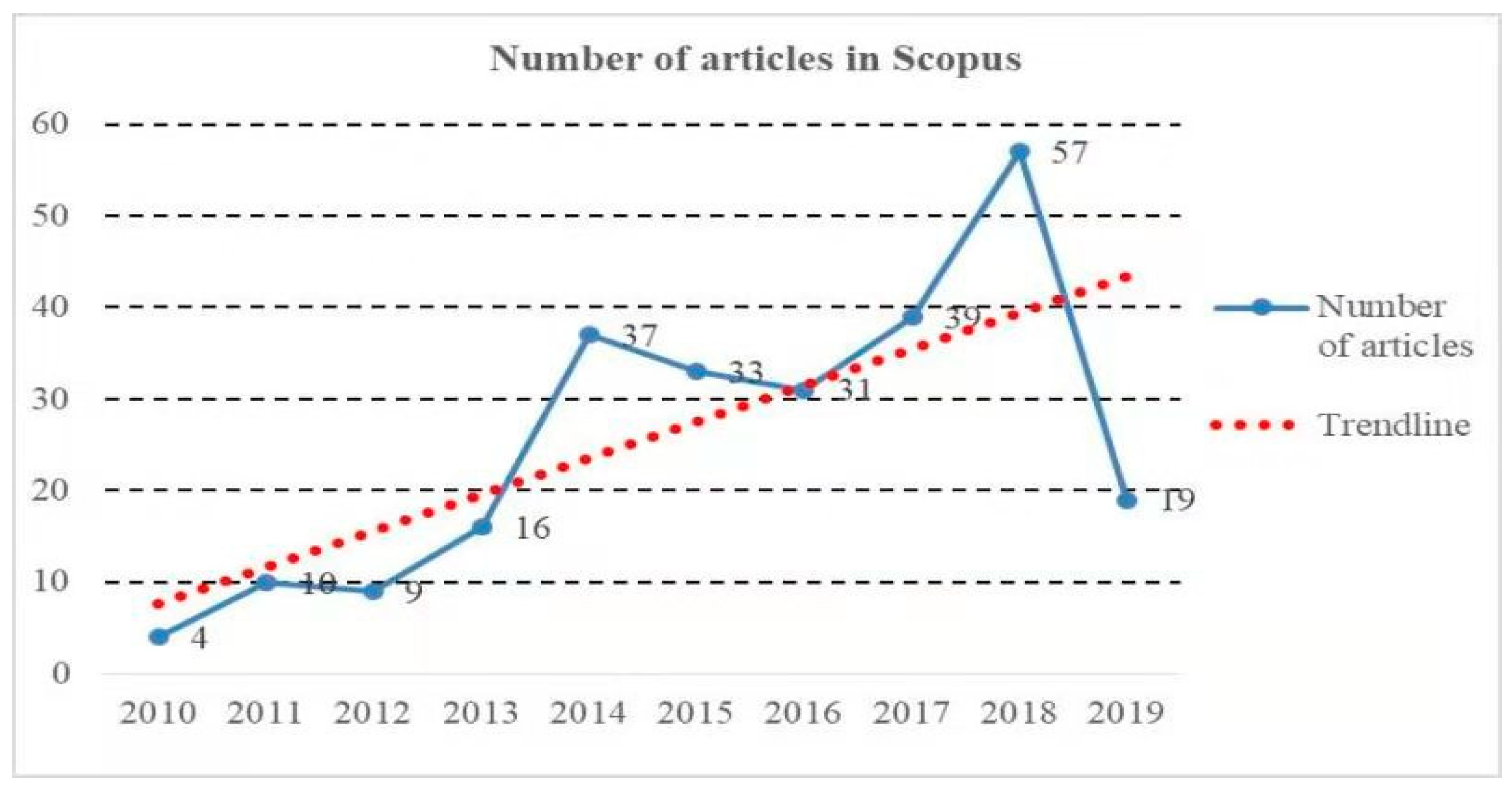
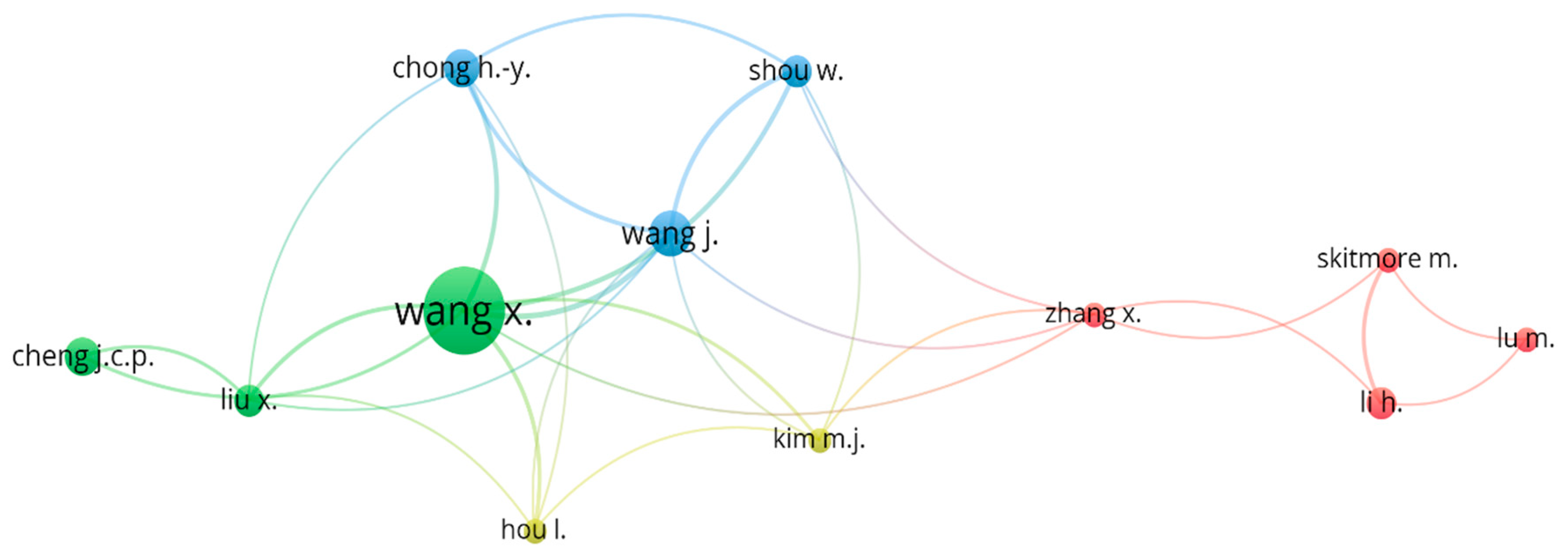
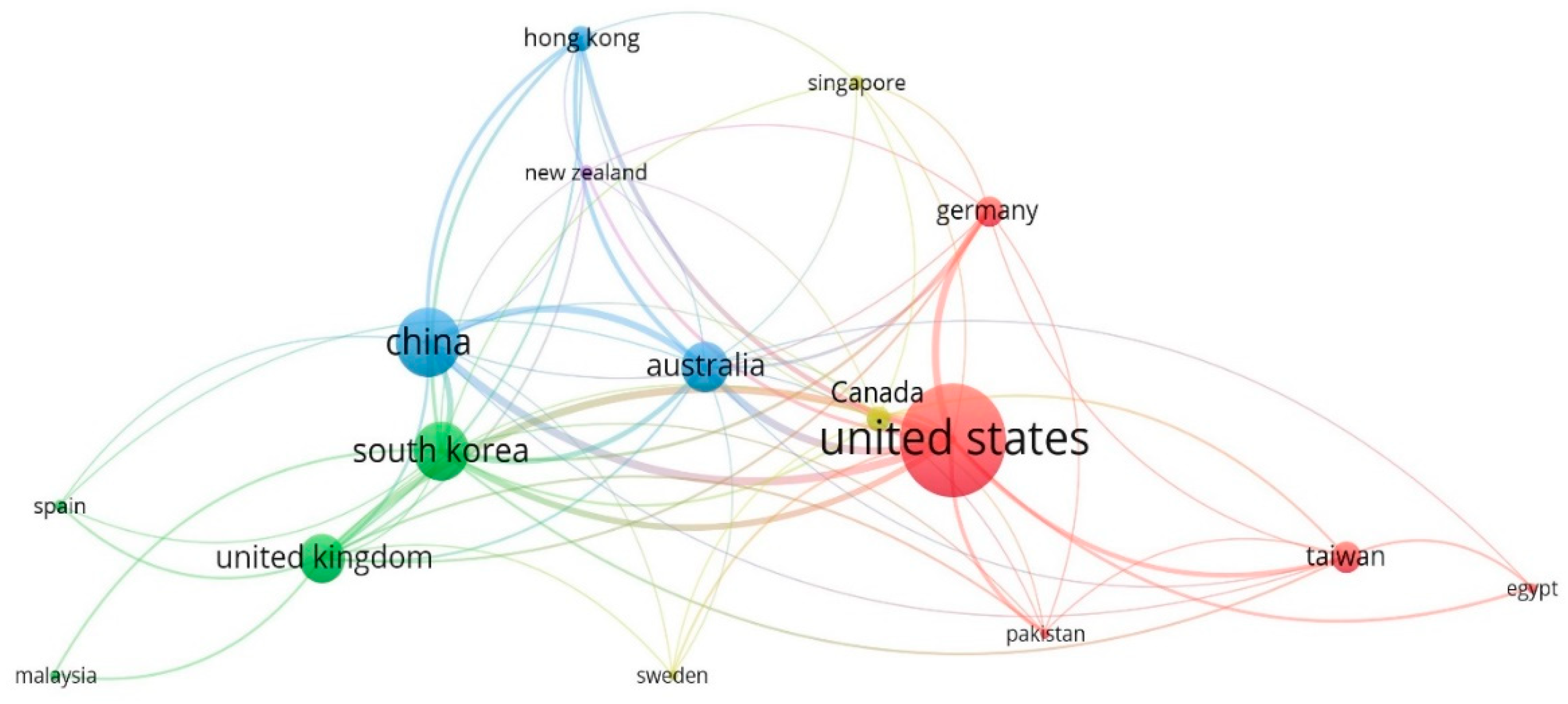
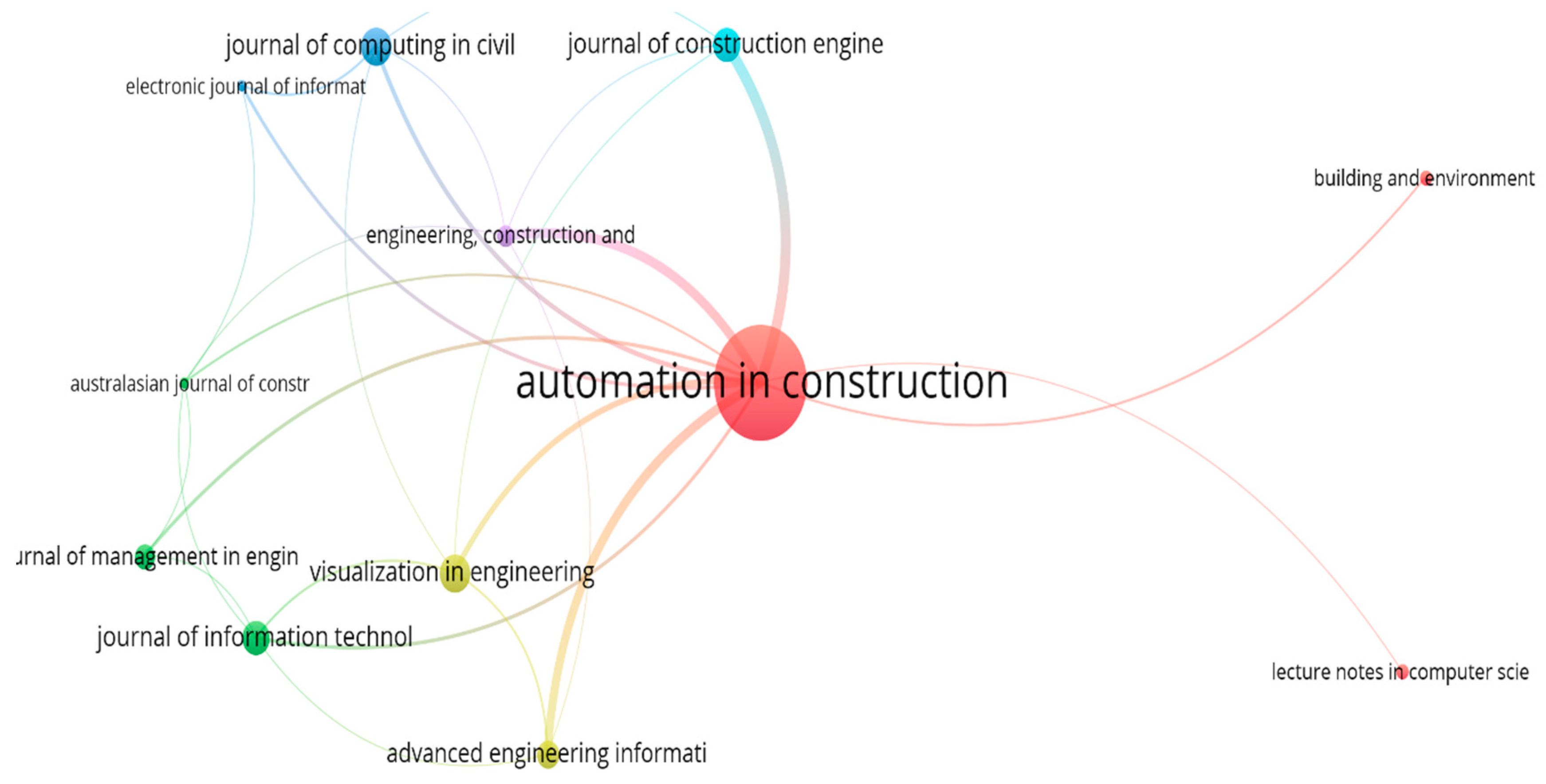
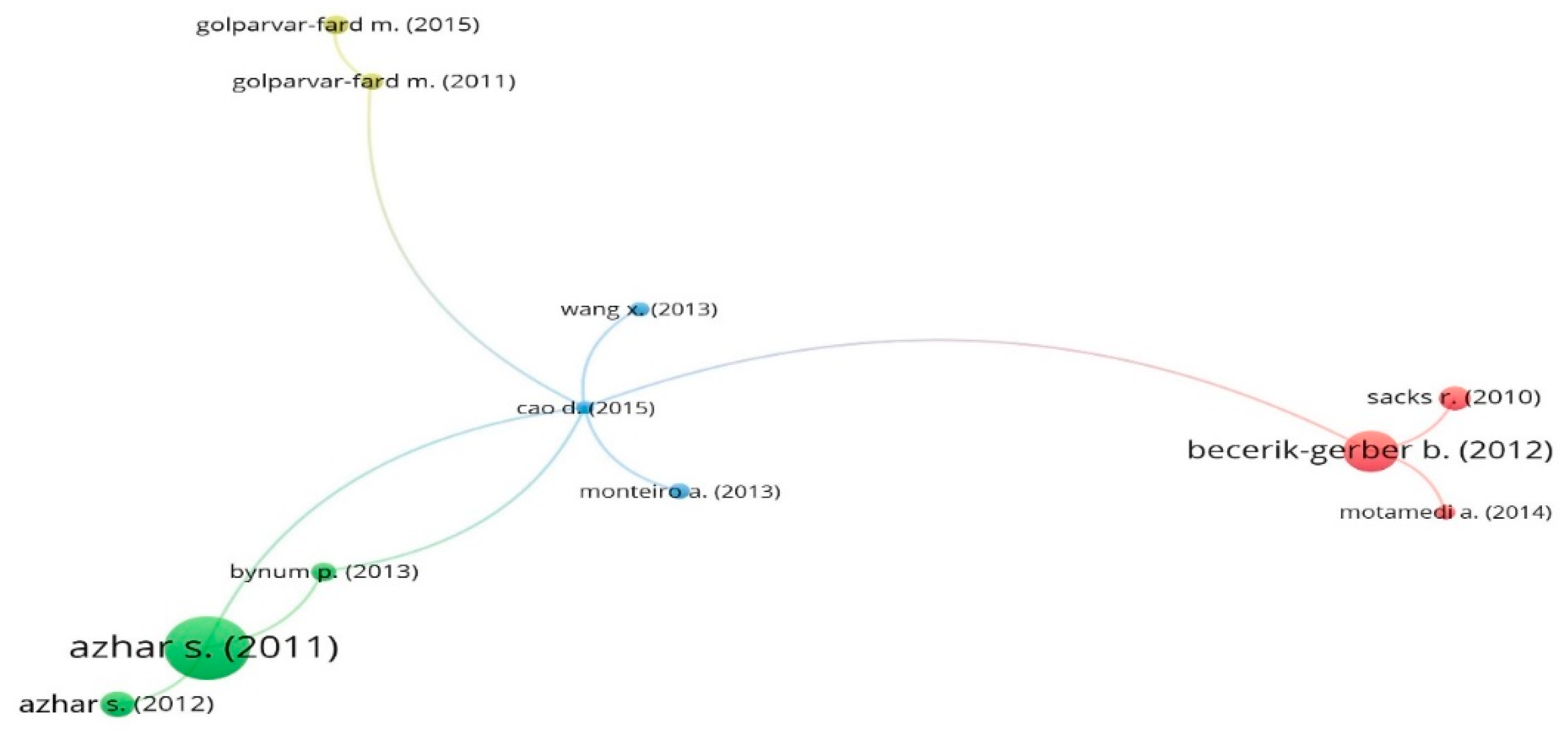

| Scholar | Affiliation | Documents | Citations | Avg. Citations | Avg. Pub. Year | Avg. Norm. Citations |
|---|---|---|---|---|---|---|
| Wang X. | Curtin University | 13 | 273 | 21 | 2015 | 1.18 |
| Wang J. | Curtin University | 6 | 81 | 14 | 2015 | 0.71 |
| Cheng J.C.P. | Hong Kong University of Science and Technology | 5 | 40 | 8 | 2018 | 2.05 |
| Chong H.Y. | Curtin University | 5 | 46 | 9 | 2015 | 0.92 |
| Li H. | Hong Kong Polytechnic University | 4 | 103 | 26 | 2016 | 1.51 |
| Liu X. | Curtin University | 4 | 38 | 10 | 2016 | 1.04 |
| Shou W. | Curtin University | 4 | 78 | 20 | 2014 | 1.02 |
| Hou L. | Curtin University | 3 | 96 | 32 | 2014 | 0.92 |
| Kim M.J. | Kyung Hee University | 3 | 116 | 39 | 2014 | 1.22 |
| Lu M. | Hong Kong Polytechnic University | 3 | 48 | 16 | 2016 | 1.28 |
| Skitmore M. | Queensland University of Technology | 3 | 101 | 34 | 2016 | 1.71 |
| Zhang X. | City University of Hong Kong | 3 | 49 | 16 | 2016 | 0.97 |
| Country/Region | Documents | Citations | Avg. Pub. Year | Avg. Citations | Avg. Norm. Citations |
|---|---|---|---|---|---|
| United States | 70 | 1760 | 2015 | 25 | 1.20 |
| China | 39 | 256 | 2017 | 7 | 0.79 |
| South Korea | 33 | 687 | 2016 | 21 | 1.06 |
| Australia | 27 | 743 | 2015 | 28 | 1.42 |
| United Kingdom | 26 | 439 | 2016 | 17 | 1.09 |
| Taiwan | 16 | 117 | 2016 | 7 | 0.71 |
| Germany | 15 | 235 | 2017 | 16 | 1.03 |
| Canada | 12 | 160 | 2017 | 13 | 0.93 |
| Hong Kong | 12 | 168 | 2017 | 14 | 1.98 |
| New Zealand | 6 | 62 | 2017 | 10 | 0.81 |
| Singapore | 6 | 14 | 2018 | 2 | 1.07 |
| Spain | 5 | 57 | 2016 | 11 | 0.31 |
| Egypt | 4 | 76 | 2015 | 19 | 0.87 |
| Malaysia | 4 | 10 | 2017 | 3 | 0.23 |
| Pakistan | 4 | 79 | 2015 | 20 | 1.20 |
| Sweden | 4 | 59 | 2015 | 15 | 0.74 |
| Full Name of Journal Sources | Documents | Citations | Avg. Citations | Avg. Norm. Citations |
|---|---|---|---|---|
| Automation in Construction | 40 | 1392 | 35 | 1.90 |
| Journal of Computing in Civil Engineering | 11 | 222 | 20 | 0.98 |
| Visualization in Engineering | 11 | 73 | 7 | 0.45 |
| Journal of Construction Engineering and Management | 10 | 551 | 55 | 1.93 |
| Electronic Journal of Information Technology in Construction | 10 | 121 | 12 | 0.79 |
| Advanced Engineering Informatics | 8 | 70 | 9 | 0.89 |
| Journal of Management in Engineering | 7 | 136 | 19 | 2.08 |
| Engineering, Construction and Architectural Management | 6 | 17 | 3 | 0.34 |
| Building and Environment | 4 | 56 | 14 | 1.13 |
| Lecture Notes in Computer Science (including subseries lecture notes in artificial intelligence and lecture notes in bioinformatics) | 4 | 18 | 5 | 0.27 |
| Australasian Journal of Construction Economics and Building | 3 | 196 | 65 | 1.52 |
| Electronic Journal of Information Technology in Construction | 3 | 125 | 42 | 0.74 |
| Article | Title | Citations | Norm. Citations |
|---|---|---|---|
| Azhar [40] | Building information modeling (BIM): trends, benefits, risks, and challenges for the AEC industry | 465 | 6.0944 |
| Becerik-Gerber, Jazizadeh, Li and Calis [42] | Application areas and data requirements for BIM-enabled facilities management | 266 | 4.1926 |
| Azhar, et al. [50] | Building information modeling (BIM): now and beyond | 147 | 2.317 |
| Sacks, Radosavljevic and Barak [44] | Requirements for building information modeling based lean production management systems for construction | 132 | 2.9333 |
| Bynum, Issa and Olbina [45] | Building information modeling in support of sustainable design and construction | 98 | 2.2529 |
| Golparvar-Fard, Pena-Mora and Savarese [46] | Automated progress monitoring using unordered daily construction photographs and IFC-based building information models | 95 | 4.1633 |
| Golparvar-Fard, Peña-Mora and Savarese [47] | Integrated sequential as-built and as-planned representation with D4 AR tools in support of decision-making tasks in the AEC/FM industry | 86 | 1.1271 |
| Monteiro and Poças Martins [49] | A survey on modeling guidelines for quantity takeoff-oriented BIM-based design | 75 | 1.7241 |
| Wang, Love, Kim, Park, Sing and Hou [48] | A conceptual framework for integrating building information modeling with augmented reality | 72 | 1.6552 |
| Motamedi, Hammad and Asen [43] | Knowledge-assisted BIM-based visual analytics for failure root cause detection in facilities management | 67 | 4.044 |
| Cao, Wang, Li, Skitmore, Huang and Zhang [41] | Practices and effectiveness of building information modelling in construction projects in china | 63 | 2.761 |
| Keywords | Occurrences | Avg. Pub. Year | Avg. Citations | Avg. Norm. Citations |
|---|---|---|---|---|
| Building Information Modeling | 187 | 2016 | 19 | 1.09 |
| Visualization | 28 | 2015 | 11 | 0.67 |
| Building Information Model | 17 | 2016 | 22 | 0.69 |
| Industry Foundation Class | 17 | 2016 | 13 | 1.07 |
| Collaboration | 10 | 2014 | 67 | 1.17 |
| Facility Management | 9 | 2016 | 11 | 2.21 |
| GIS | 9 | 2014 | 30 | 1.41 |
| Information Technology | 8 | 2015 | 87 | 2.22 |
| Virtual Reality | 8 | 2017 | 14 | 0.88 |
| Design | 6 | 2016 | 21 | 0.65 |
| Integration | 6 | 2014 | 12 | 0.63 |
| Ontology | 6 | 2017 | 21 | 1.31 |
| Augmented Reality | 5 | 2015 | 35 | 1.06 |
| Cloud Computing | 5 | 2015 | 19 | 1.90 |
| Communication | 5 | 2014 | 8 | 0.48 |
| Construction | 5 | 2016 | 23 | 0.85 |
| Lean Construction | 5 | 2015 | 42 | 2.00 |
| 3D Visualization | 4 | 2016 | 16 | 0.58 |
| 4D CAD | 4 | 2014 | 27 | 1.42 |
| Construction Safety | 4 | 2016 | 23 | 1.21 |
| Data Visualization | 4 | 2016 | 10 | 0.66 |
| Information Management | 4 | 2015 | 26 | 2.01 |
| Interoperability | 4 | 2014 | 39 | 0.99 |
| Safety | 4 | 2016 | 10 | 0.71 |
| Simulation | 4 | 2016 | 10 | 0.52 |
| Sustainability | 4 | 2015 | 40 | 1.64 |
| Visual Programming Language | 4 | 2017 | 4 | 0.36 |
© 2019 by the authors. Licensee MDPI, Basel, Switzerland. This article is an open access article distributed under the terms and conditions of the Creative Commons Attribution (CC BY) license (http://creativecommons.org/licenses/by/4.0/).
Share and Cite
Wu, Z.; Chen, C.; Cai, Y.; Lu, C.; Wang, H.; Yu, T. BIM-Based Visualization Research in the Construction Industry: A Network Analysis. Int. J. Environ. Res. Public Health 2019, 16, 3473. https://doi.org/10.3390/ijerph16183473
Wu Z, Chen C, Cai Y, Lu C, Wang H, Yu T. BIM-Based Visualization Research in the Construction Industry: A Network Analysis. International Journal of Environmental Research and Public Health. 2019; 16(18):3473. https://doi.org/10.3390/ijerph16183473
Chicago/Turabian StyleWu, Zezhou, Changhong Chen, Yuzhu Cai, Chen Lu, Hao Wang, and Tao Yu. 2019. "BIM-Based Visualization Research in the Construction Industry: A Network Analysis" International Journal of Environmental Research and Public Health 16, no. 18: 3473. https://doi.org/10.3390/ijerph16183473
APA StyleWu, Z., Chen, C., Cai, Y., Lu, C., Wang, H., & Yu, T. (2019). BIM-Based Visualization Research in the Construction Industry: A Network Analysis. International Journal of Environmental Research and Public Health, 16(18), 3473. https://doi.org/10.3390/ijerph16183473






